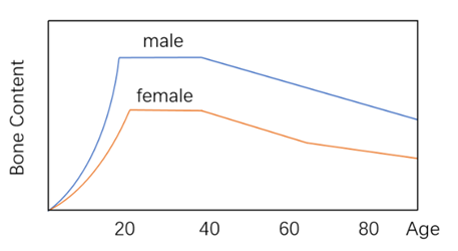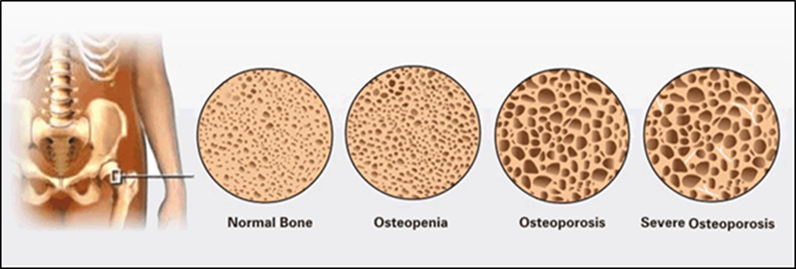
 milk
milk

 2017-09-21
2017-09-21

 0
0

 6033
6033
Although bones may seem like hard and lifeless structures, bones are living tissues that are like muscle. Bones respond to exercise and a healthy diet by becoming stronger. Bones make up our skeletons and provide structure and support for our bodies. However, bones also act like a storehouse for minerals that our bodies need, such as calcium.
During a person's lifetime, the body constantly breaks down old bone (through a process called resorption) and builds up new bone.Any time old bone is broken down faster than new bone is made, net bone loss occurs. Bone loss can lead to low bone density, weakness of the bone, and eventually lead to the pathogenesis as well as the aetiology of certain metabolic bone diseases such as osteoporosis.


There are some simple steps can be taken to prevent or slow bone loss,like eating a diet high in calcium, eating a diet high in Vitamin D, exercising ,quitting smoking and limiting alcohol intake.In fact, the natural polyamines spermidine and spermine can also prevent bone loss. Maybe you'll be confused,what are spermidine and spermine and why they play a role in bone remodeling?Well, let's continue.
Spermidine and spermine which belong to polyamines,can be found in vertebrates, as well as their precursor, the diamine putrescine. The history of the polyamines began in 1678 with the discovery by Leeuwenhoek of the crystallization of spermine from human semen.And they play important roles in cell physiology including effects on the structure of cellular macromolecules, gene expression, protein function, nucleic acid and protein synthesis, regulation of ion channels, and providing protection from oxidative damage.
In a study, spermidine or spermine, given in drinking water for 28 days, significantly prevented the increased osteoclast surface/bone surface ratio and the reduced bone volume following OVX in mice. Either spermidine or spermine significantly inhibited the increased number of multinucleated TRAP-positive cells in osteoclasts cultured with RANKL in a concentration-dependent manner without affecting cell survival. That is to say,spermidine and spermine prevent bone loss through the disruption of differentiation and maturation of osteoclasts, rather than affecting osteoblasts[1].
Then how do our body get spermidine and spermine?
Soybeans have the highest amount of spermidine and spermine among different natural foods[2] .
As both spermidine and spermine are not enzymically degraded in the alimentary tract, these two polyamines taken orally should be quickly absorbed from the intestinal lumen and distributed to all organs and tissues [3]. We would propose that the appropriate consumption of soybean and soy products could be beneficial for the maintenance of bone health and the prophylaxis of menopausal osteoporosis through a mechanism linked to the preventive profiles of particular polyamines.Moreover,daily oral supplementation with the natural polyamines spermidine and spermine is also a good choice.
Expand reanding:Osteoclasts are multinucleated cells derived from hematopoietic stem cells shared with macrophage and dendritic cell lineages[4], while the osteoblast lineage is derived from primitive multipotent mesenchymal stem cells with potential to differentiate into bone marrow stromal cells, chondrocytes, muscles and adipocytes[5]. Imbalance between regulations by osteoclasts and osteoblasts leads to the pathogenesis as well as the aetiology of certain metabolic bone diseases.
References
[1] Yamamoto T, Hinoi E, Fujita H, et al. The natural polyamines spermidine and spermine prevent bone loss through preferential disruption of osteoclastic activation in ovariectomized mice[J]. British Journal of Pharmacology, 2012, 166(3):1084–1096.
[2]Okamoto A, Sugi E, Koizumi Y, Yanagida F, Udaka S. Polyamine content of ordinary foodstuffs and various fermented foods. Biosci Biotechnol Biochem. 1997;61:1582–158
[3]Bardócz S, Duguid TJ, Brown DS, Grant G, Pusztai A, White A, et al. The importance of dietary polyamines in cell regeneration and growth. Br J Nutr. 1995;73:819–828.
[4]Boyle WJ, Simonet WS, Lacey DL. Osteoclast differentiation and activation. Nature. 2003;423:337–342
[5]Harada S, Rodan GA. Control of osteoblast function and regulation of bone mass. Nature. 2003;423:349–355
Diabetes, often referred to by doctors as diabetes mellitus, des... More

 0
0

 0
0
According to research, myricetin stimulates glucose transport in... More

 0
0

 1
1
In vivo, betaine acts as a methyl donor for the conversion of h... More

 0
0

 0
0
There are many studies at the molecular, biochemical, organism a... More

 0
0

 0
0
Apigenin, an abundant dietary flavonoid, is emerging as a potent... More

 0
0

 0
0
BVC synergised with thiazolidinediones, which are synthetic PPAR... More

 0
0

 0
0
Epicatechin is an antioxidant flavonoid, occurring especially in... More

 6
6

 2
2
Fatigue is a very common phenomenon. There are many reasons can ... More

 2
2

 1
1
There are some simple steps can be taken to prevent or slow bone... More

 0
0

 0
0
Echinacea is also called the magic herb that can bring health to... More

 0
0

 0
0
Obesity has become a global health issue. It is a medical condit... More

 0
0

 0
0
Cardiac hypertrophy is the myocardial response to various pathol... More

 7
7

 1
1
Aging is becoming an international challenge to healthcare syste... More

 0
0

 0
0
Asthma is a common long-term inflammatory disease of the airways... More

 0
0

 0
0
Studies have shown that this compound possesses a plethora of b... More

 0
0

 0
0
